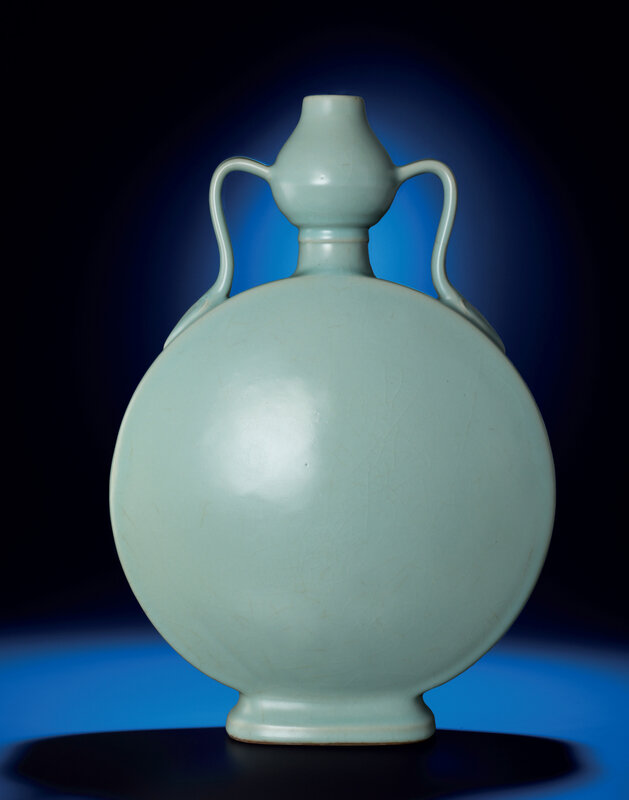A fine and massive Ru-type glazed moonflask, Yongzheng six-character seal mark and of the period (1723-1735)
Lot 3966. A fine and massive Ru-type glazed moonflask, Yongzheng six-character seal mark and of the period (1723-1735); 21 in. (53.3 cm.) high. Estimate 8,000,000 - HKD 10,000,000. Price realised HKD 7,820,000. © Christie's Images Ltd 2012.
The flattened circular body is well-potted rising from the splayed rectangular foot with countersunk base to the pear-shaped mouth above a waisted neck. Applied to the sides is a pair of long strap handles terminating at the shoulder in ruyi heads. It is covered overall in a bluish grey glaze, except for the foot rim with a brown dressing, Japanese wood box.
Provenance: Collection of Xu Shichang (1855-1939), and thence by descent.
Note: Xu Shichang was a key political figure in the history of early modern China. He passed the civil examinations and became a jinshi in 1886. Xu was appointed a position at the Hanlin Academy of the Qing government before being promoted to Governor of the Three Northeast Provinces. Later Xu became President of the Republic of China (Beijing government) from 1918 to 1922 but after retiring from office he lived in Tianjin where he focused on the scholarly pursuits of painting, calligraphy and poetry.
The elegant form of the current vase was greatly influenced by early Ming blue and white moonflasks such as the two examples in the collection of the National Palace Musuem, Taipei, illustrated in Blue-and-White Ware of the Ming Dynasty, Hong Kong, 1963, Book II, Part 1, pp. 38-41, pls. 9-10c. Yongzheng vases of this form and large size are very rare and the current vase stands out as an exceptional example of the Yongzheng adaptation of the Song dynasty Ru glaze. A very similar Ru-type glazed vase of this shape but slightly larger in size (57 cm.) was sold at Sotheby's London, 12 July 2006, lot 131. A related Yongzheng Guan-type moonflask with an incurved garlic mouth (52.7 cm. high), was included in the exhibition Etheral Elegance: Porcelain Vases of the Imperial Qing, The Huaihaitang Collection, Chinese University of Hong Kong, 2007, pl. 31.
The Yongzheng Emperor appears to have had particular admiration of Ru wares, and a number of vessels from his reign were made with fine Ru-style glazes. It is possible that the copy of Song dynasty Ru ware glazes made for the Yongzheng Emperor was devised by the greatest of all the supervisors of the imperial kilns, Tang Ying, who first came to the kilns as resident assistant in 1728. Tang Ying was especially known for his highly successful imitation of early wares. Indeed the Jingdezhen tao lu notes that: 'His close copies of famous wares of the past were without exception worthy partners (of the originals); and his copies of every kind of well-known glaze were without exception cleverly matched ...' translated by R. Kerr in Chinese Ceramics - Porcelain of the Qing Dynasty 1644-1911, London, 1986, p. 20.
Christie's. The Imperial Sale, Hong Kong, 30 May 2012

/https%3A%2F%2Fprofilepics.canalblog.com%2Fprofilepics%2F1%2F0%2F100183.jpg)
/https%3A%2F%2Fstorage.canalblog.com%2F03%2F02%2F119589%2F96711876_o.jpg)
/https%3A%2F%2Fstorage.canalblog.com%2F11%2F31%2F119589%2F94773502_o.jpg)
/https%3A%2F%2Fstorage.canalblog.com%2F20%2F83%2F119589%2F94772815_o.jpg)
/https%3A%2F%2Fstorage.canalblog.com%2F26%2F72%2F119589%2F75604929_o.jpg)
/https%3A%2F%2Fstorage.canalblog.com%2F59%2F60%2F119589%2F26458628_o.jpg)



/http%3A%2F%2Fstorage.canalblog.com%2F20%2F81%2F119589%2F128051102_o.jpg)
/http%3A%2F%2Fstorage.canalblog.com%2F90%2F60%2F119589%2F127643380_o.jpg)
/http%3A%2F%2Fstorage.canalblog.com%2F38%2F93%2F119589%2F127181225_o.jpg)
/http%3A%2F%2Fstorage.canalblog.com%2F96%2F07%2F119589%2F126439485_o.jpg)